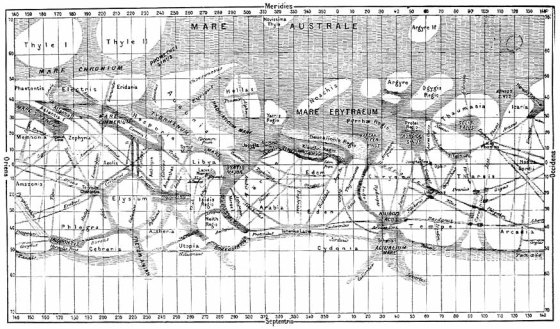
Welcome to a special A to Z Challenge edition of Sciency Words! Sciency Words is an ongoing series here on Planet Pailly about the definitions and etymologies of science or science-related terms. In today’s post, N is for:
NOACHIAN
In the 1870’s, Italian astronomer Giovanni Schiaparelli began producing the most detailed and accurate maps of Mars anyone had ever seen. Schiaparelli also assigned many of the names we still use today for Martian surface features today. One of those regions on Schiaparelli’s map got the name Noachis Terra—the Land of Noah.
In my opinion, no other name could have turned out to be more apt. Schiaparelli got many of his names from the Bible, and I’m sure you remember the biblical story of Noah and the Great Flood.

Much like the geological history of Earth, Mars’s geological history is divided up into different periods. Noachis Terra spawned the name for Mars’s Noachian Period, a time that roughly corresponds with the Archean Eon here on Earth—the time when the very first microbes were appearing on our planet.
So what was happening on Noachian Mars? Based on the evidence presented in this textbook on Astrobiology, it wasn’t quite like the Great Flood in the Bible, but it was close! Most if not all of Mars’s northern hemisphere was probably covered in water. Circumstantial evidence of shorelines can be seen today.
And in the southern hemisphere, in regions like Noachis Terra, we see unambiguous evidence of ancient flowing water. Craters show obvious signs of erosion. There are dried up lakes and rivers, and those rivers appear to have been fed by tributaries, which tells us it used to rain on Mars.
And there’s more. Many Noachian-aged minerals and rock formations are most easily explained if we assume there was water. In some cases, water is the only possible explaination. Our Mars rovers have found mudstone, clay minerals, sedimentary rock… iron and magnesium carbonate… hematite, jarosite, and more! Some of these minerals would have required a hot and slightly acidic environment, like you might find in a hot spring or near a hydrothermal vent.
We shouldn’t jump to conclusions. After all, there’s still so much we don’t yet know about Mars, and new discoveries are being made all the time. But I’m going to go ahead and call a spade a spade here: Noachian Mars sounds an awful lot like Arcean Earth, and it’s easy to imagine that whatever was happening on Arcean Earth (by which I mean LIFE!!!) must’ve also been happening on Noachian Mars.
However, the Noachian Period did not last long—a mere 400 million years. Earth and Mars have had very different geological histories since then. After the Noachian, Mars rapidly lost its internal heat, its atmosphere, and its oceans. By the time of Earth’s Cambrian explosion, when complex, multi-cellular organisms really “exploded” onto the scene, Mars had fully transformed into the barren, inhospitable world we know today.
Modern day Mars has been trying really hard to get our attention and convince us that it might still support life.

And maybe that’s true. During the Noachian, life had a great opportunity to get started on Mars, and it’s possible that some isolated remnant of a Noachian ecosystem has persisted to this day. But in my opinion, it’s far more likely that we’ll find fossils left over from the Noachian Period (assuming we haven’t found some already).
Next time on Sciency Words A to Z, did you know there’s a deadly chemical in the air you breathe? It’s called oxygen.
Poor Mars.
LikeLiked by 1 person
Earth is thinking about loaning a few organisms to Mars at some point. So even if Mars doesn’t have life now, it probably will in the future.
LikeLiked by 1 person
When phobos crashes, it could warm mars to the right temperature for life
LikeLiked by 1 person
Only briefly, I’d think, if at all. Mars doesn’t have enough of an atmosphere to hold onto any heat the impact might generate. Unless Phobos happens to hit a polar ice cap, vaporizing the CO2 ice and thus causing a global greenhouse effect.
LikeLike